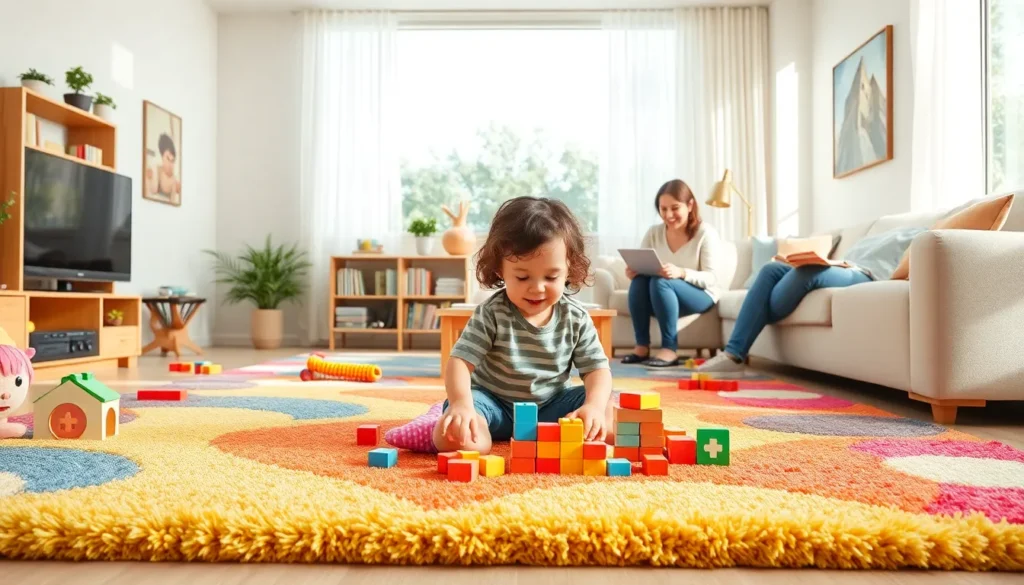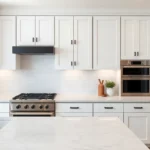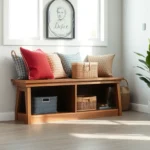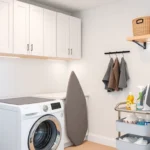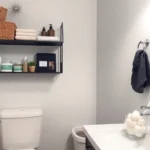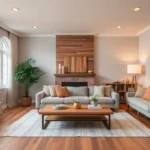Creating a dedicated play space for kids within your living room can transform your home into a functional and fun environment for the whole family. We know how challenging it can be to balance adult aesthetics with children’s needs while maintaining an organized and stylish space.
Modern families are discovering that incorporating thoughtful play areas into their main living spaces doesn’t mean sacrificing design or functionality. With smart storage answers creative furniture choices and strategic zoning techniques we can help you create a seamless blend of grown-up sophistication and child-friendly fun.
Whether you’re working with a spacious open-plan layout or a cozy compact living room there are countless ways to establish an captivating play zone that grows with your children. From multi-purpose furniture that hides toys to designated corners that spark imagination we’ll explore practical ideas that make your living room work harder for your family’s lifestyle.
Create a Designated Corner Play Zone
Transforming an underutilized corner into a functional play area maximizes your living room’s potential while maintaining the overall aesthetic. We’ll show you how to establish boundaries and create an organized space that keeps toys contained yet easily accessible.
Choose the Right Corner Location
Select corners away from high traffic pathways to prevent accidents and disruptions during family gatherings. Natural light from nearby windows enhances the play experience and makes the area more inviting for children.
Avoid corners near entertainment centers or formal seating areas where noise and activity might interfere with adult conversations or relaxation time. Consider proximity to electrical outlets if you plan to include electronic toys, learning tablets, or night lights.
Measure the corner dimensions carefully before committing to ensure adequate space for both sitting and standing play activities. Most corner play zones require at least 4×4 feet to accommodate toddlers and preschoolers comfortably.
Use Area Rugs to Define the Space
Large area rugs create clear visual boundaries that signal to children where their play space begins and ends. Choose rugs measuring at least 5×7 feet to provide sufficient room for building blocks, puzzles, and imaginative play scenarios.
Washable rugs prove essential for managing inevitable spills, create projects, and snack accidents in active play areas. Materials like polypropylene or cotton blends resist stains while maintaining vibrant colors that appeal to young children.
Textured or patterned rugs add sensory elements that enhance developmental play experiences through touch and visual stimulation. Road maps, alphabet designs, or geometric patterns encourage learning while defining the designated play boundary.
Install Corner Shelving for Toy Storage
Floating corner shelves maximize vertical storage without consuming valuable floor space needed for active play. Install shelves at varying heights to accommodate different toy sizes and allow children to reach frequently used items independently.
Corner ladder shelves provide multiple storage tiers while creating an attractive display for books, stuffed animals, and educational toys. These units typically measure 18-24 inches wide and fit snugly into standard corner spaces.
Cube storage systems with fabric bins offer flexible organization options that grow with your child’s changing interests and toy collections. Label each bin with pictures and words to encourage independent cleanup and develop early literacy skills.
Transform Under-Stair Space Into a Mini Playroom
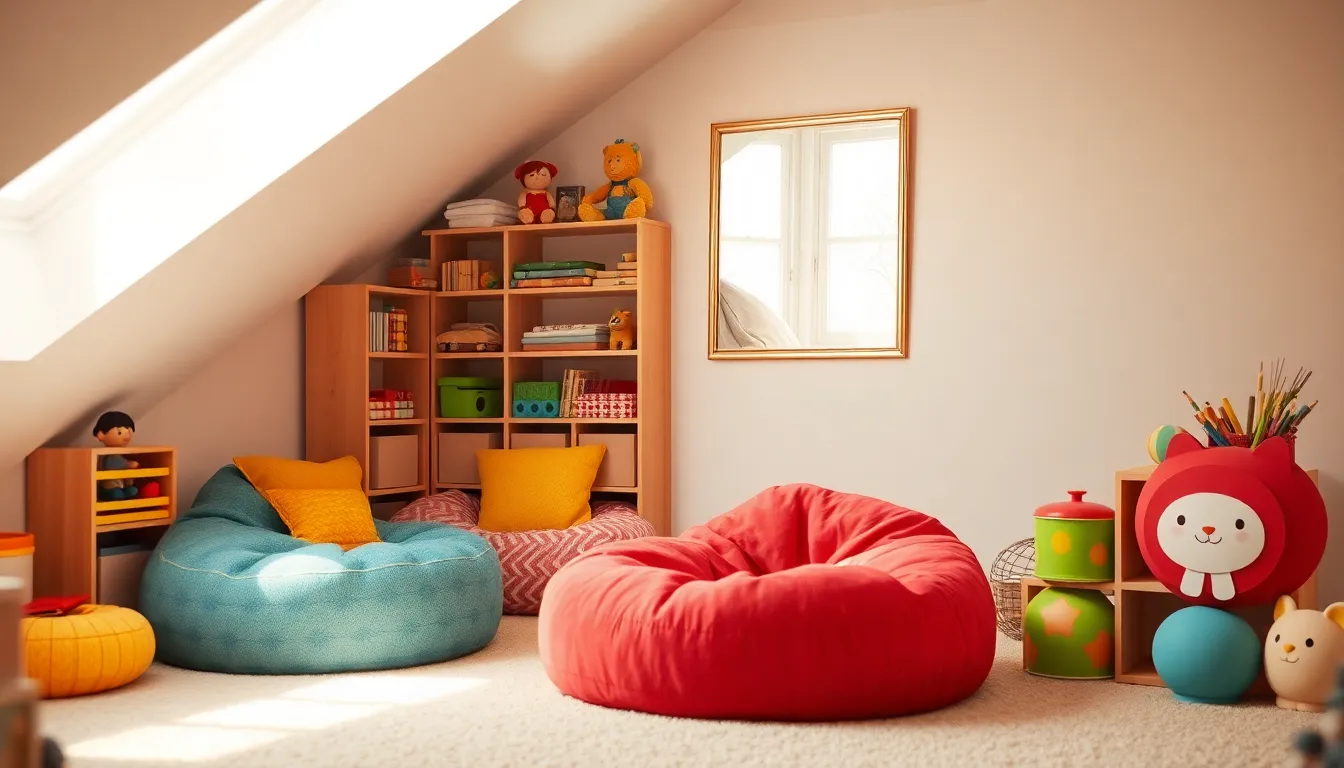
Under stair spaces offer untapped potential for creating magical play areas that children absolutely love. We can turn these often overlooked nooks into functional mini playrooms that maximize every square foot of our living space.
Maximize Low-Height Areas
Creating cozy reading nooks underneath stairs gives children their own special hideaway within the living room. We’ll install small cushioned seating areas like bean bags or floor pillows that fit perfectly in the reduced height space. Small furniture pieces such as toddler tables and chairs work exceptionally well in these areas since the low ceiling doesn’t restrict movement.
Storage optimization becomes crucial when working with under stair spaces. We can use the varying heights to our advantage by placing taller storage bins toward the back where ceiling height allows and shorter containers toward the front. Toy organization improves dramatically when we designate exact zones for different activities like blocks, dolls, or art supplies.
Safety considerations require us to check for sharp edges or protruding elements that could pose hazards in tight spaces. We’ll add soft padding to any hard surfaces and ensure adequate ventilation in enclosed under stair areas.
Add Custom Built-in Storage
Wall mounted shelving maximizes vertical space without taking up precious floor area in compact under stair locations. We can install floating shelves at varying heights to accommodate books, small toys, and decorative storage baskets. Cube storage systems work particularly well because they provide individual compartments for different toy categories.
Built in cabinets with doors help maintain a clean aesthetic while hiding toy clutter from the main living area. We’ll choose cabinet doors that match our existing living room decor to create visual continuity. Pull out drawers make accessing toys easier for children and encourage independent cleanup habits.
Custom answers might include built in desk areas for older children or art supply storage with dedicated spaces for crayons, paper, and create materials. We can incorporate charging stations for tablets or learning devices within the built in storage design.
Install Proper Lighting Answers
Soft ambient lighting creates a warm and inviting atmosphere in under stair play areas that might otherwise feel dark or cramped. We’ll use table lamps with warm LED bulbs to provide gentle illumination that’s comfortable for extended play sessions. Battery operated lights offer flexibility in areas where electrical outlets aren’t easily accessible.
Task exact lighting helps children engage in detailed activities like puzzles, coloring, or reading. We can install under cabinet LED strips beneath built in shelving to illuminate play surfaces without creating harsh shadows. String lights add a magical element that children love while providing adequate ambient lighting.
Natural light enhancement involves using mirrors strategically to reflect available light from nearby windows into the under stair space. We’ll position mirrors safely out of children’s reach while maximizing their light reflecting benefits. Light colored paint on walls and ceiling helps brighten the space and makes it feel more open and welcoming.
Design a Multi-Functional Coffee Table Play Area
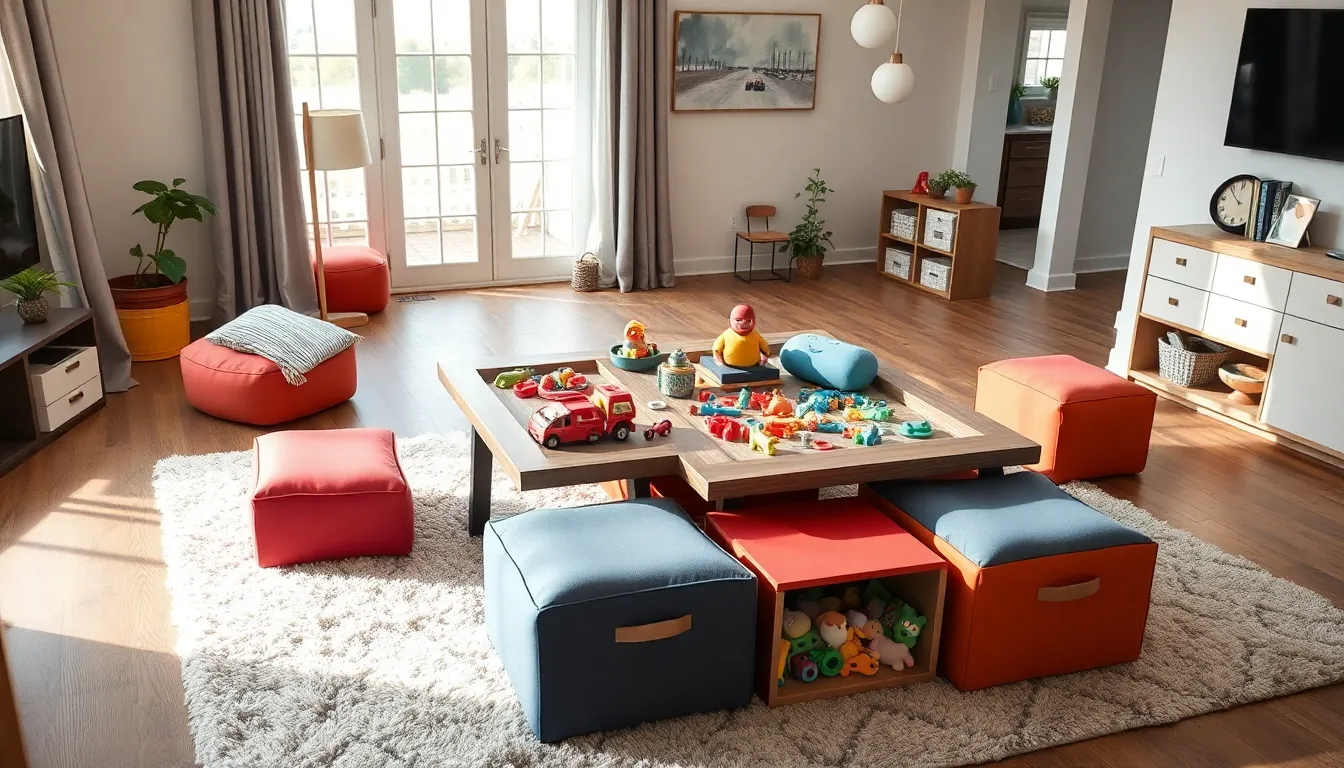
Coffee tables can transform into powerful dual-purpose furniture pieces that serve both adults and children seamlessly. We’ll explore how to create an captivating play zone while maintaining your living room’s sophisticated appeal.
Select Storage Ottoman Coffee Tables
Storage ottomans offer the perfect combination of functionality and comfort for family living spaces. We recommend choosing ottomans with lift-top lids that reveal spacious compartments capable of holding toys, books, and art supplies. These versatile pieces provide additional seating when friends visit while keeping play materials organized and easily accessible.
Soft cushioned tops create comfortable surfaces where children can sit while playing board games or working on puzzles. We suggest selecting ottomans with removable, washable covers to handle inevitable spills and messes. Round or square storage ottomans work best in most living room layouts, allowing easy movement around the furniture.
Multiple smaller ottomans can replace a single large coffee table, creating flexible seating arrangements that adapt to different activities. We find that ottomans with safety hinges prevent lid slamming and protect little fingers during play sessions.
Choose Kid-Safe Table Materials
Durable, non-toxic materials ensure your coffee table withstands daily family use while keeping children safe. We prioritize solid wood options with rounded edges that eliminate sharp corners and reduce injury risks. Natural wood finishes like oak or maple provide timeless appeal and resist scratches from toys and activities.
Metal frames with powder-coated finishes offer modern aesthetics while maintaining durability against frequent use. We recommend avoiding glass surfaces entirely in homes with young children, as they create safety hazards and show fingerprints constantly.
Plastic laminate surfaces provide easy cleanup after art projects and snack time while remaining budget-friendly. We suggest testing any finishes for smoothness, ensuring rough edges won’t catch on clothing or cause scrapes during active play.
Incorporate Hidden Toy Compartments
Hidden storage compartments maintain your living room’s clean aesthetic while providing strategic toy organization. We design coffee tables with sliding panels or removable tops that reveal designated spaces for different toy categories. These compartments should remain accessible enough for children to retrieve and store items independently.
Built-in dividers within hidden compartments separate small toys from larger items, preventing the frustrating search for missing pieces. We recommend installing soft-close mechanisms on any moving parts to ensure quiet operation during adult conversations or TV viewing.
Secret storage drawers on the table’s sides offer additional space for art supplies or books without disrupting the main surface area. We find that compartments sized appropriately for children’s hands encourage regular cleanup and maintain organization throughout the day.
Establish a Reading Nook with Play Elements
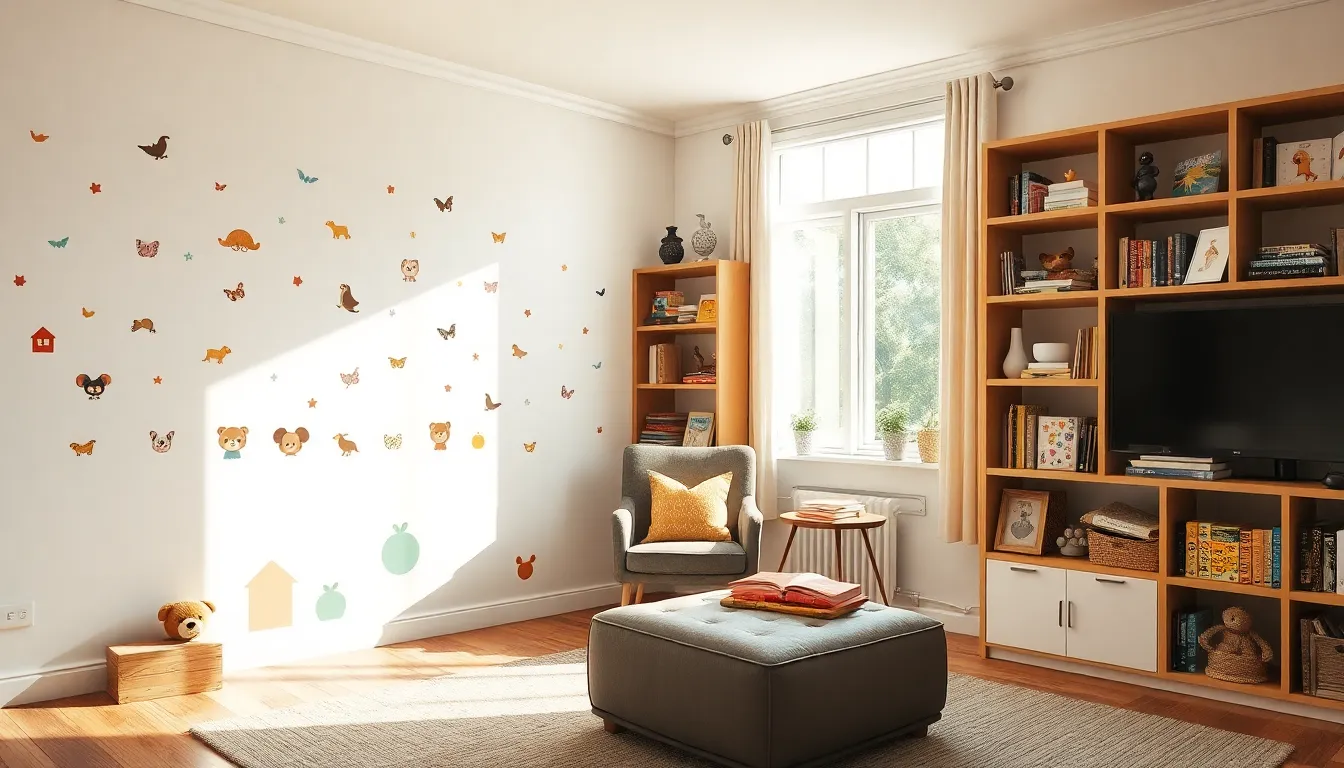
Building a dedicated reading space transforms any living room corner into a literary adventure zone that encourages both quiet time and active play. We’ll show you how to create a balanced environment that nurtures your child’s love for books while maintaining the sophisticated look of your main living space.
Create Cozy Seating Areas
Position soft seating options at child height to make reading feel natural and inviting. We recommend placing a cushioned chair and ottoman near a window where natural light enhances the reading experience. Consider adding a low toy storage bench that doubles as extra seating during story time. Round coffee tables with built-in shelving provide the perfect surface for spreading out books while keeping additional toys within easy reach. Matching accent chairs create conversation areas where parents and children can read together, fostering close interaction and shared literary moments.
Add Interactive Wall Decals
Transform blank wall space into an captivating backdrop that sparks imagination without cluttering the floor. We suggest using removable wall decals featuring favorite book characters, alphabet designs, or nature scenes that complement your existing decor. Interactive elements like peek-a-boo flaps or textured surfaces encourage tactile exploration during reading breaks. Wall shelves positioned at various heights display favorite books like artwork while serving as functional storage. These vertical answers maximize your reading nook’s potential without overwhelming the surrounding living room space.
Include Accessible Book Storage
Open shelving at child level promotes independent book selection and develops organizational skills from an early age. We place low bookshelves within easy reach so children can browse their collection and put books away without assistance. Lidded baskets offer flexible storage for both books and small toys, maintaining the area’s dual purpose as a play and reading zone. Forward-facing book displays showcase colorful covers that attract young readers and make choosing books feel like selecting treasures. This accessible approach creates a learning-friendly environment that encourages autonomous exploration and reading habits.
Install Wall-Mounted Play Features

Wall-mounted play features transform vertical living room spaces into interactive zones while preserving valuable floor space for movement and furniture.
Mount Fold-Down Play Tables
Fold-down play tables offer the perfect solution for families seeking flexible workspace options without permanent furniture additions. We recommend installing sturdy wall-mounted brackets that can support at least 50 pounds to accommodate art supplies, puzzles, and create projects safely. These space-saving tables fold flat against the wall when not in use, maintaining the living room’s clean aesthetic while providing instant access to creative activities.
Choose tables with smooth, washable surfaces that can handle markers, paints, and playdough without staining. Position the mounting height between 22 to 26 inches from the floor to accommodate children ages 3 to 8 comfortably. Adding small storage pouches or magnetic containers underneath the table keeps supplies organized and prevents clutter from spreading throughout the room.
Add Magnetic or Chalkboard Walls
Magnetic walls encourage creativity while serving as functional display spaces for children’s artwork and learning materials. We suggest using magnetic paint or adhesive magnetic sheets to transform a section of wall into an interactive surface without permanent alterations. This approach works particularly well on accent walls or spaces behind furniture where the magnetic surface won’t dominate the room’s design.
Chalkboard walls provide endless opportunities for drawing, writing practice, and educational games that grow with your child’s development. Apply chalkboard paint in designated sections or install removable chalkboard panels that can be repositioned as needed. Consider framing the chalkboard area with decorative molding to create a polished look that complements your living room’s style. Keep chalk stored in nearby wall-mounted containers to prevent dust from spreading to upholstered furniture.
Create Vertical Toy Storage Answers
Vertical toy storage maximizes wall space while keeping play materials accessible and organized at child-friendly heights. We recommend installing floating shelves between 18 to 36 inches from the floor, creating multiple levels for different toy categories and age-appropriate access. Cube storage systems mounted on walls provide individual compartments for books, blocks, and small toys while maintaining visual organization.
Wall-mounted toy storage bins eliminate floor clutter and encourage independent cleanup habits in children. Choose clear or labeled containers that allow kids to identify contents quickly and return items to their designated spaces. Install hooks at varying heights for dress-up clothes, bags, and hanging toys that add visual interest while serving practical storage needs. Safety straps secure heavier storage units to wall studs, preventing tip-over hazards while supporting the weight of multiple toys and supplies.
Use Room Dividers to Section Play Space

Room dividers transform your living room into distinct zones without permanent structural changes. We can create organized play spaces that contain toys while maintaining the room’s open feel and adult aesthetic.
Choose Portable Folding Screens
Folding screens offer maximum flexibility for defining our children’s play areas. We can quickly set up these portable dividers when play time begins and easily store them away when we need the full living room space. These screens allow us to adjust the size and shape of the play zone based on our current needs.
Moving these lightweight dividers takes just seconds, making them perfect for families who entertain frequently. We can position screens to block toy clutter from main seating areas while still allowing supervision. Many folding screens feature decorative patterns or colors that complement our living room decor while appealing to children.
Install Bookshelf Room Dividers
Bookshelf dividers serve dual purposes by creating boundaries and providing essential storage space. We can use low, open bookshelves strategically placed to act as partial barriers between play and living areas. These dividers help keep our living room tidy by offering designated spots for toys, books, and decorative items.
Open shelving maintains visual flow between spaces while clearly defining each zone. We can fill lower shelves with colorful toy bins and upper shelves with adult books or decor. This approach maximizes our storage capacity while creating natural boundaries that feel intentional rather than restrictive.
Create Curtain Play Boundaries
Curtains provide the softest approach to dividing our living room play space. We can install ceiling mounted rods or tension rods to hang fabric panels that draw closed during play time and open when we need full room access. This solution adds textural interest and warmth while creating flexible boundaries.
Drawing curtains gives children a sense of having their own special space while maintaining our ability to supervise easily. We can choose washable fabrics in colors that coordinate with our existing decor. Curtain dividers work especially well in rental homes since they require minimal installation and leave no permanent marks.
Design a Toy Rotation System

We’ve found that implementing a strategic toy rotation system transforms our living room play areas from chaotic clutter zones into organized, captivating spaces. This approach keeps children interested while maintaining the sophisticated aesthetic we want in our main living areas.
Organize Toys in Labeled Bins
Labeled storage bins revolutionize how children interact with their play space by creating clear categories for different toy types. We recommend using picture labels alongside words to help pre-readers identify where toys belong, making cleanup an independent activity rather than a parent-directed chore.
Clear plastic bins work exceptionally well because children can see contents at a peek, reducing frustration during play searches. Different colored bins can represent various categories like building blocks, art supplies, dress-up clothes, or puzzle pieces, creating a visual system that even toddlers can master.
Stackable storage answers maximize vertical space while keeping frequently used toys at child-accessible heights. We position everyday favorites in lower bins and rotate seasonal or special occasion toys to higher shelves, maintaining easy access to current interests.
Create Seasonal Toy Swaps
Seasonal toy rotation keeps our living room play areas fresh and prevents overwhelming children with too many choices simultaneously. We store three-quarters of toys away and rotate them every 4-6 weeks, creating excitement when “new” toys reappear.
Holiday-themed rotations work particularly well for maintaining engagement throughout the year. Summer might bring out water play toys and outdoor games, while winter introduces puzzles, create supplies, and cozy reading materials that complement indoor activities.
Birthday and special occasion toys get integrated into regular rotation cycles, ensuring expensive gifts don’t become forgotten clutter. We track rotation dates using a simple calendar system, noting which bins were swapped and when to maintain consistent freshness.
Maintain Clutter-Free Living Spaces
Daily cleanup routines become manageable when we establish clear toy boundaries and storage expectations from the beginning. We carry out a “one bin out, one bin away” rule that prevents overwhelming accumulation while teaching children responsibility for their belongings.
Evening toy sweeps take just 5-10 minutes when everything has a designated home, making this routine sustainable for busy families. Children can participate meaningfully in cleanup when storage systems are intuitive and accessible, building independence while maintaining our living room’s adult-friendly appearance.
Strategic placement of toy storage ensures our rotation system doesn’t dominate the living space visually. We use furniture pieces that serve dual purposes, like storage ottomans or bench seating with hidden compartments, keeping the rotation system functional but discreet.
Incorporate Soft Play Elements
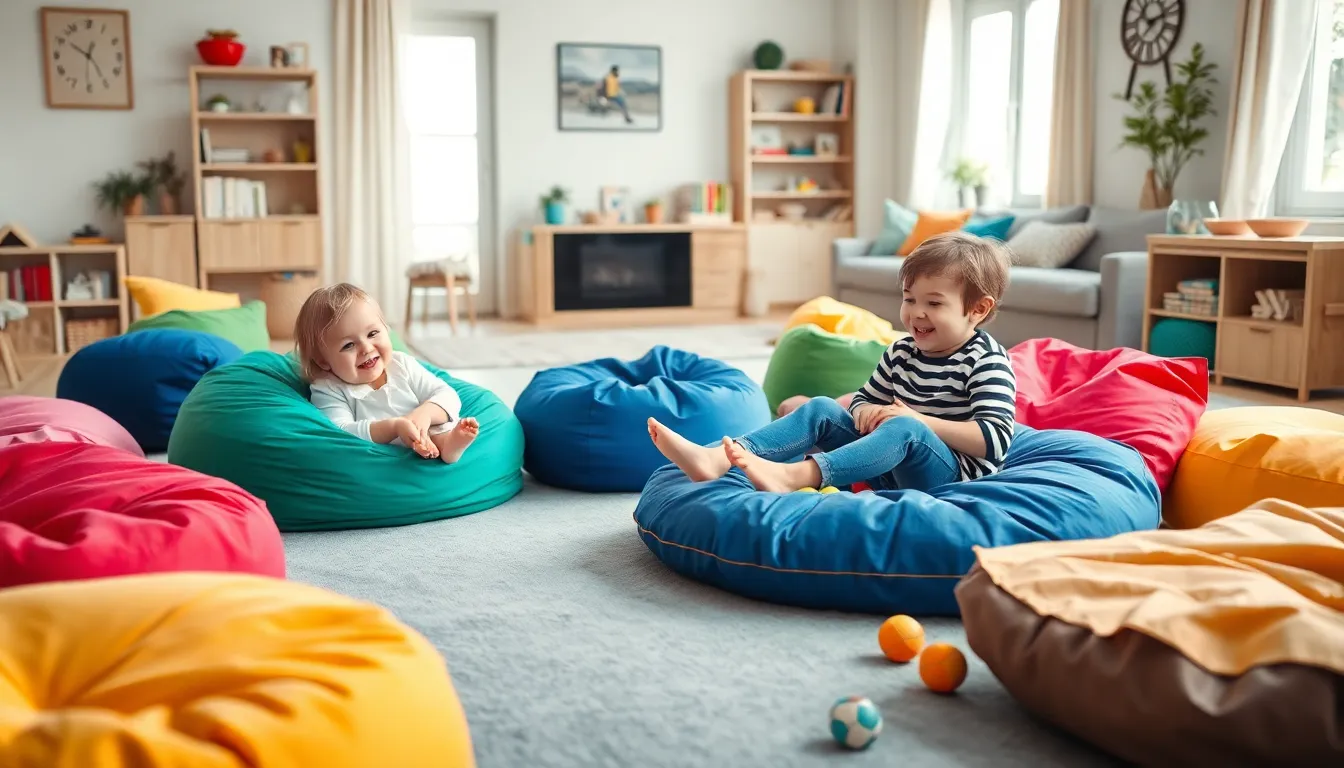
Soft play elements transform hard living room surfaces into comfortable spaces where children can safely explore and play. These additions create cushioned zones that reduce injury risks while maintaining the room’s adult-friendly aesthetic.
Add Floor Cushions and Bean Bags
Floor cushions create comfortable seating areas that naturally define your play space boundaries. We recommend selecting cushions in sizes ranging from 18 to 24 inches square, providing adequate support for children aged 2 to 10 years. Bean bags offer flexible seating that adapts to different play activities, from quiet reading sessions to active games.
Strategic placement near walls or corners helps establish clear play zones without permanent furniture changes. Large floor cushions can accommodate multiple children during group activities like puzzles or board games. We suggest choosing neutral colors or patterns that complement your existing living room decor while still appealing to children’s preferences.
Removable covers make maintenance easier when spills or accidents occur. Stackable cushions provide storage convenience when the play area needs quick cleanup for adult entertaining.
Install Foam Floor Tiles
Foam floor tiles provide essential safety cushioning that protects children from falls on hard surfaces. These interlocking tiles typically measure 12×12 inches or 24×24 inches, with thickness options ranging from 0.5 to 2 inches for varying impact protection levels.
Installation requires no special tools or permanent modifications to your flooring. We recommend choosing tiles with textured surfaces that provide better grip during active play while remaining comfortable for sitting activities. Waterproof foam options resist spills and allow for easy cleaning with standard household cleaners.
Borders and edge pieces create finished appearances that blend seamlessly with existing flooring. Removable tiles allow you to adjust the play area size based on daily needs or special occasions. Quality foam tiles can support up to 1,000 pounds, making them suitable for adult supervision during playtime.
Choose Washable Fabric Options
Washable fabrics ensure your soft play elements maintain cleanliness and durability even though frequent use by active children. We prioritize machine-washable materials like cotton blends, microfiber, and synthetic fabrics that withstand regular washing cycles without losing shape or color.
Performance fabrics with stain-resistant treatments help repel spills and make cleanup more manageable. Removable zippered covers on cushions and bean bags allow for individual washing without replacing entire pieces. We recommend having backup covers to maintain continuous use while others are being cleaned.
Darker colors and busy patterns effectively hide minor stains between washes, extending the time between deep cleaning sessions. Quick-dry fabrics reduce downtime when immediate cleaning becomes necessary. Choosing fabrics rated for commercial or heavy residential use ensures longevity in high-traffic play areas.
Create Activity Zones for Different Ages

Creating distinct areas for different age groups ensures every child can engage safely while maximizing our living room’s functionality. We’ll establish zones that grow with our children while maintaining visual harmony throughout the space.
Design Toddler-Safe Low Areas
Toddler areas require furniture that sits close to the ground for easy access and maximum safety. We recommend selecting ottomans, small chairs, and low play tables that allow toddlers to climb on and off independently without risk of falls. Floor-level storage cubes serve dual purposes as seating and toy containers while keeping everything within reach.
Soft surfaces become essential elements around toddler zones to cushion inevitable tumbles and falls. Large foam play mats create defined boundaries while providing comfortable crawling and sitting spaces. We suggest layering washable area rugs over these mats to add texture and visual appeal while maintaining easy cleanup capabilities.
Safety features should extend beyond soft surfaces to include rounded furniture corners and secured storage bins. Toddler zones benefit from wall-mounted toy storage that prevents climbing hazards while keeping favorite items visible and accessible. We recommend positioning these areas away from sharp coffee table edges and electrical outlets for maximum protection.
Establish School-Age Create Stations
School-age children need dedicated workspace that accommodates their growing creativity and fine motor skills. A properly sized create table becomes the centerpiece of this zone, positioned at the ideal height for comfortable drawing, writing, and project work. We suggest tables measuring 24-26 inches high for most elementary-aged children.
Storage answers for create materials require organization systems that children can manage independently. Rolling carts with multiple compartments keep supplies sorted while allowing easy transport between projects. Wall-mounted organizers with clear pockets provide visible storage for frequently used items like markers, scissors, and glue sticks.
Lighting considerations become crucial for detailed create work and assignments activities. We recommend positioning create stations near natural light sources when possible, supplemented with adjustable desk lamps for evening use. Task lighting reduces eye strain while creating an inviting workspace that encourages extended creative sessions.
Include Multi-Age Play Features
Multi-age features allow siblings to play together while accommodating different developmental stages simultaneously. Building blocks, magnetic tiles, and open-ended construction toys engage toddlers through school-age children with varying complexity levels. We suggest investing in quality wooden blocks or large foam blocks that withstand years of creative play.
Versatile furniture pieces maximize space efficiency while serving multiple age groups effectively. Storage benches provide seating for older children while offering safe climbing surfaces for toddlers. Ottoman tables can host tea parties for preschoolers and board games for elementary students, adapting to different play styles throughout the day.
Shared reading areas create bonding opportunities between siblings of different ages while promoting literacy development. We recommend creating cozy floor seating with cushions and blankets where older children can read to younger siblings. Forward-facing book displays allow toddlers to browse picture books while school-age children access chapter books from higher shelves.
Maximize Vertical Storage Solutions
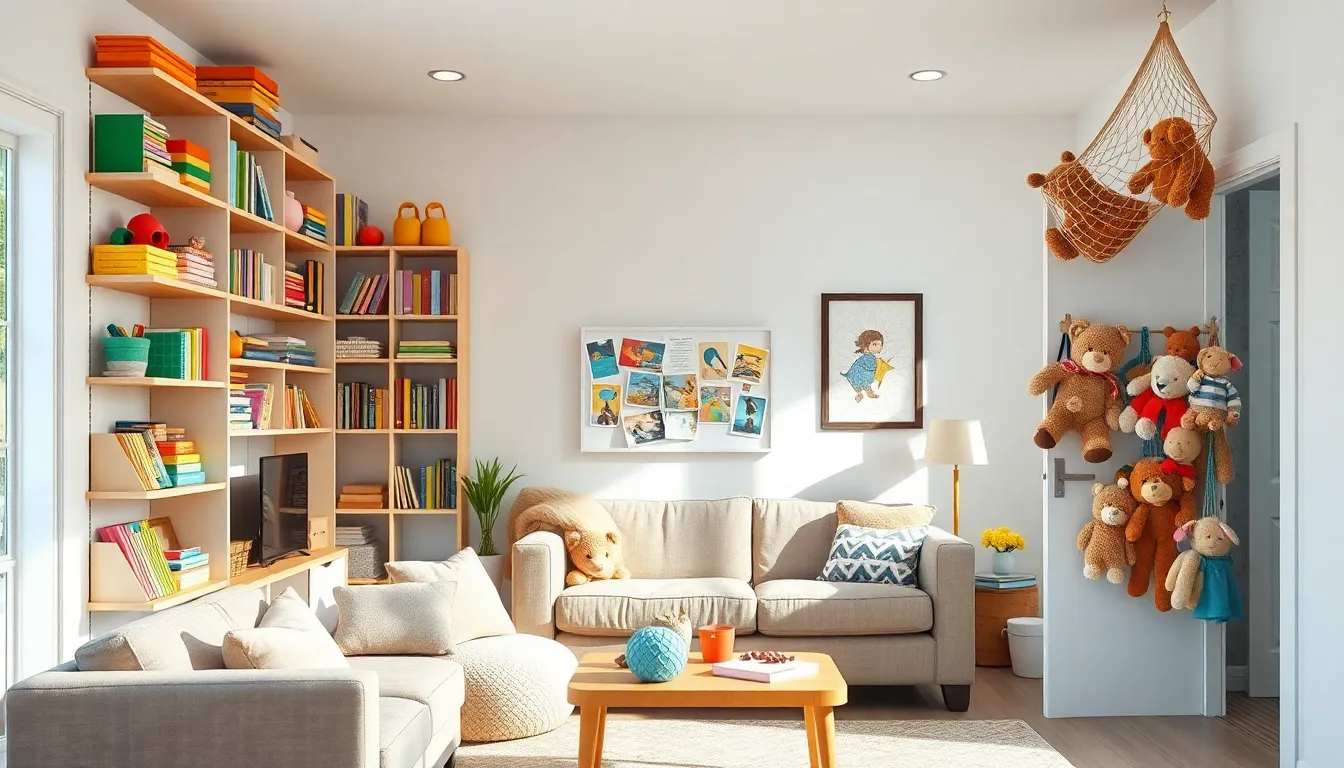
We can transform our living room’s vertical space into a powerful storage solution that keeps toys organized while maintaining our adult aesthetic. These vertical strategies free up valuable floor space for active play while ensuring everything has its designated place.
Install High Shelving Units
Mounting shelves at higher levels creates ample storage space for toys, books, and decorative items while keeping them safely out of children’s reach yet accessible to adults. We recommend installing floating shelves or cube storage systems 5-6 feet above the floor to store items that aren’t needed daily. This approach reduces trip hazards by keeping the floor area completely clear for play activities.
Rotating toys from high shelves provides variety in our children’s play experience while making cleanup significantly easier. We can store seasonal toys, create supplies, or books that require adult supervision on these elevated surfaces. Installing brackets that support at least 25 pounds ensures our shelving remains secure even when fully loaded with heavier items like board games or storage bins.
Use Over-Door Organizers
Over-door storage answers maximize otherwise wasted space by utilizing the back of doors throughout our living room area. We can hang clear pocket organizers to hold art supplies, small toys, or frequently used books that children access independently. These organizers install without permanent modifications and keep items visible yet contained.
Choosing organizers with varying pocket sizes accommodates different types of play materials from crayons to action figures. We recommend selecting over-door units with at least 12 pockets to provide adequate organization for multiple categories of toys. Installing these on closet doors or room entry doors creates accessible storage that doesn’t interfere with our living room’s visual flow.
Add Ceiling-Mounted Storage
Ceiling-mounted nets and hanging baskets store soft toys like stuffed animals or dress-up clothes while remaining visually unobtrusive in our living space. We can install these storage answers in corners or above play areas where they won’t interfere with adult activities. Using ceiling hooks rated for at least 15 pounds ensures our hanging storage remains secure during regular use.
Installing pulley systems for ceiling storage allows us to raise and lower baskets as needed, making items accessible for both children and adults. We recommend positioning ceiling-mounted storage at least 7 feet high to prevent head bumps while maintaining easy access with a step stool. These storage options maintain our room’s tidy appearance while providing ample space for bulky toys that would otherwise clutter floor areas.
Conclusion
Creating a kids play area in your living room doesn’t mean sacrificing style or adult comfort. With the right strategies—from corner play zones to multi-functional furniture—we can design spaces that serve everyone in the family beautifully.
The key lies in choosing versatile answers that grow with your children while maintaining your home’s aesthetic appeal. Smart storage systems wall-mounted features and soft play elements work together to create boundaries without permanent changes.
Remember that successful play areas adapt to your family’s changing needs. By implementing toy rotation systems and age-appropriate zones we’re building spaces that encourage creativity independence and family bonding for years to come.
Frequently Asked Questions
How can I create a play area in my living room without ruining the adult aesthetic?
Use smart storage solutions like storage ottoman coffee tables and floating shelves to maintain a clean look. Choose neutral-colored rugs to define the play zone, and incorporate furniture with hidden toy compartments. Select materials and colors that complement your existing decor while being kid-friendly and durable.
What’s the best way to utilize corner spaces for children’s play?
Transform underutilized corners by installing corner shelving for toy storage and adding a large, washable area rug to define the space. Choose corners away from high-traffic areas with good natural light. Ensure the space accommodates both sitting and standing activities for versatile play options.
How do under-stair spaces work as mini playrooms?
Under-stair spaces maximize living room potential by creating cozy, contained play areas. Add small cushioned seating for reading nooks and use varying heights for storage bins. Always pad sharp edges and ensure proper ventilation. These spaces work perfectly for quiet activities and toy storage.
What safety considerations should I keep in mind for living room play areas?
Choose furniture with rounded edges and non-toxic materials. Pad any sharp corners and ensure proper lighting for safe play. Use washable, non-slip rugs and secure wall-mounted storage properly. Keep small items in appropriate storage to prevent choking hazards for younger children.
How can I implement an effective toy rotation system?
Use labeled storage bins to help children categorize toys independently. Choose clear plastic bins for easy visibility and stackable solutions to maximize space. Implement seasonal toy swaps to keep play areas fresh, and follow a “one bin out, one bin away” rule to maintain organization.
What are the best storage solutions for small living rooms?
Maximize vertical space with wall-mounted shelving and over-door organizers. Use multi-functional furniture like storage ottomans and floating shelves. Consider ceiling-mounted storage for soft toys and implement cube storage systems that double as seating or display areas.
How do I create age-appropriate zones for multiple children?
Design toddler-safe low areas with soft surfaces and accessible furniture. Create designated craft stations for school-age children with proper workspace organization. Use versatile furniture that accommodates various developmental stages, and establish shared reading areas to foster sibling bonding and literacy development.
What soft play elements work best in living rooms?
Add washable floor cushions and bean bags in colors that complement your decor. Use foam floor tiles for safety and easy maintenance. Choose fabrics that withstand frequent use and washing. These elements create comfortable play surfaces while maintaining the room’s adult aesthetic.

